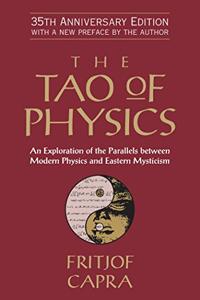
Want to learn the ideas in The Tao of Physics better than ever? Read the world’s #1 book summary of The Tao of Physics by Fritjof Capra here.
Read a brief 1-Page Summary or watch video summaries curated by our expert team. Note: this book guide is not affiliated with or endorsed by the publisher or author, and we always encourage you to purchase and read the full book.
Video Summaries of The Tao of Physics
We’ve scoured the Internet for the very best videos on The Tao of Physics, from high-quality videos summaries to interviews or commentary by Fritjof Capra.
1-Page Summary of The Tao of Physics
Overview
Science and religion are often considered entirely different concepts. Western thought is generally more rational, while Eastern thought tends to be more intuitive or spiritually oriented. However, when we compare some of the fundamental notions of major Eastern religions with modern science, especially physics, we see many similarities.
Eastern religions and quantum physics share a similar view of the world. They both believe that all things are interconnected, even if they’re invisible to our senses. The Tao of Physics was written in 1975, but its ideas still resonate with readers today because they explain how Eastern religions see the world as one big system. Quantum physics explains that there’s no space without time and vice versa; therefore it’s impossible for them to exist independently from each other.
Big Idea #1: Western science and Eastern mysticism may have clear differences, but they also share striking similarities.
Modern physics and Eastern mysticism have a lot in common. Both are highly precise disciplines that use different languages to describe the same thing. Physics uses math as its language, while mysticism relies on meditation.
However, there are some important differences between the two. One key difference is that knowledge can be broken into two types: rational and intuitive.
While science and mysticism are clearly distinct, they share some similarities. For example, both deal with knowledge that is obtained by measuring and quantifying things to classify and analyze material reality. Science is based on rational knowledge while Eastern mystics seek intuitive knowledge that goes beyond intellectual positions or sensory perceptions. They can get this through meditative states of consciousness.
Nevertheless, physics also has a rational side. Scientists would not make progress without creativity and intuition. Similarly, Eastern mysticism is based on logic as well. The only difference is that physicists use scientific experimentation to learn about the world while mystics rely on introspection for their understanding of the universe.
Despite the fact that Western philosophy and Eastern philosophy are very similar, they’re also different in some ways. Specifically, Western philosophy is based on a separation between the body and mind (Western philosophies stem from ancient Greek learning).
The ancient Greek philosopher Democritus had a theory that matter is made up of atoms, which led to the idea that there’s no such thing as spirit or soul. This became one of the core ideas in Western thought and influenced people for centuries.
In contrast, Eastern thought is based on the idea that all things are connected.
Big Idea #2: Physics has transformed over time to reach a conclusion long held by Eastern mystics.
Eastern mystics and physicists in the early 20th century had similar views of the universe. They both believed that spiritual experiences shaped their perceptions.
Modern physics has revolutionized the worldview of classical physics, which is based on Isaac Newton’s work. It was a worldview that included absolute space and time, elementary solid particles, and objective descriptions of nature regardless of the observer’s perspective.
In modern physics, we can’t speak about time without also speaking about space. For example, Einstein’s theory of relativity states that the speed of light is constant and his formula E=mc² shows us that mass is a form of energy.
Quantum theory then challenged classical physics even further by showing that the behavior of atoms and particles can’t be determined with certainty, but rather tend to occur.





